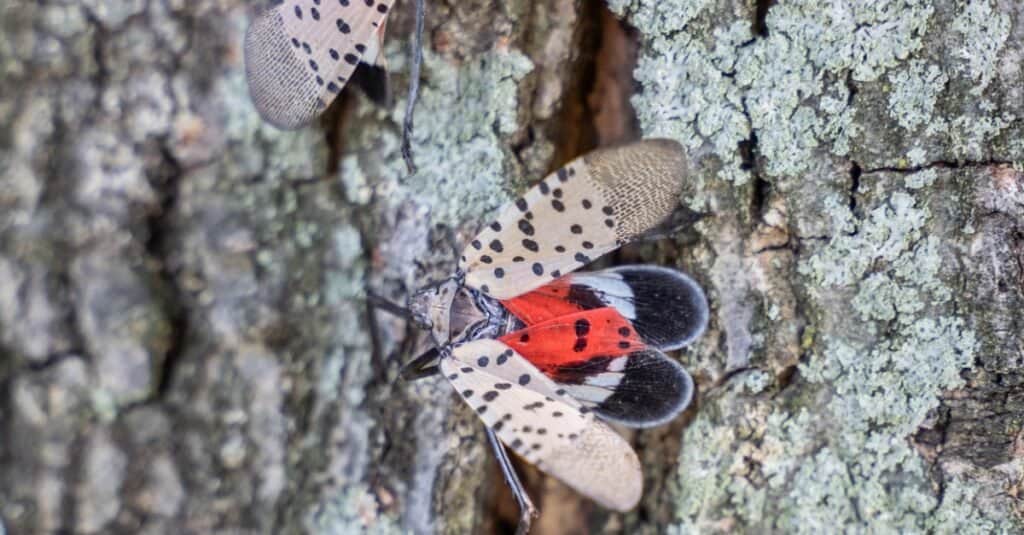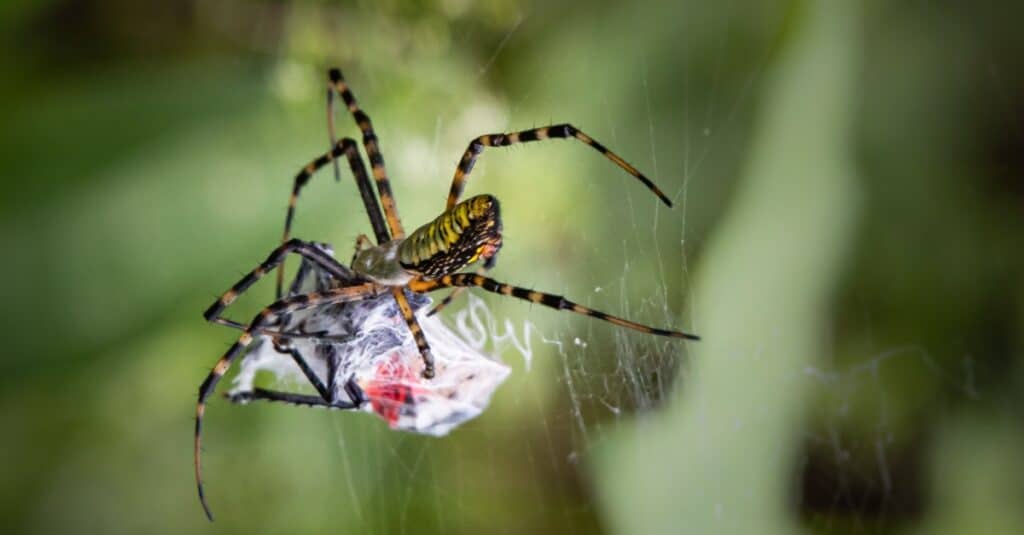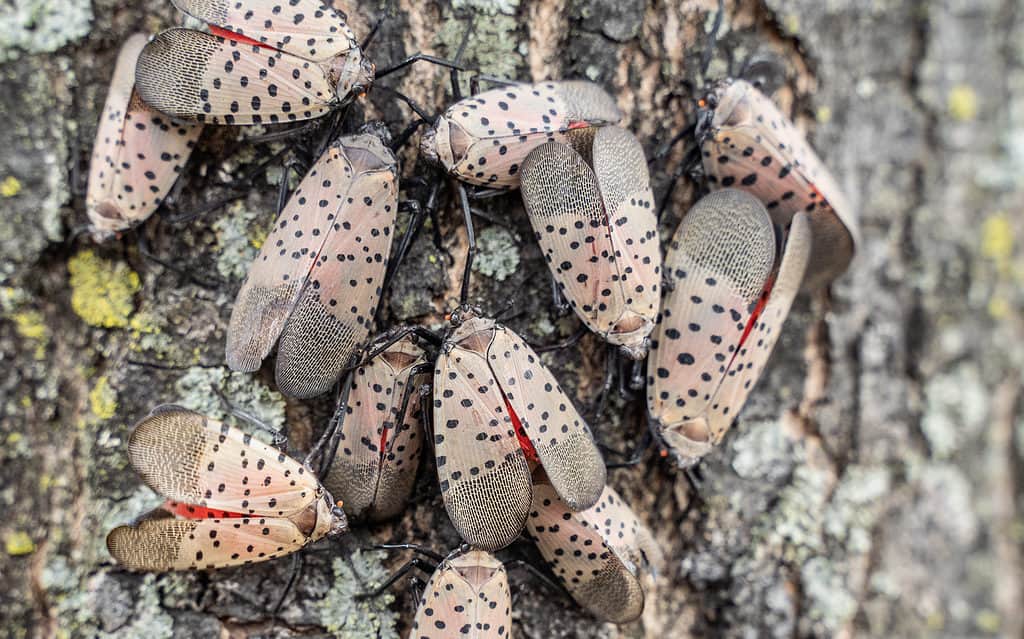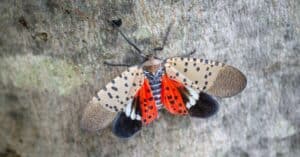Spotted lanternflies are native to China, Vietnam, and India. This insect is about one inch in length and half an inch wide. Its forewings are gray with black spots. However, this insect is most notable for its bright red hindwings covered with black spots.
Spotted lanternflies are considered an invasive species and have been found in Pennsylvania, Connecticut, New York, Massachusetts, and Maryland along with other eastern states in the United States They live in trees and on a variety of plants that contain sap.
After consuming a tree’s sap, spotted lanternflies release a liquid called ‘honeydew.’ This liquid is harmful because it attracts other destructive insects and can weaken a tree’s defenses against mold and disease. Unfortunately, a large group of lanternflies is capable of killing a crop of fruit trees.
So, do spot lanternflies have predators? These insects don’t have a lot of natural predators, which is why they can multiply quickly and threaten fruit tree crops.
Furthermore, the bright red on this insect’s hindwings serves as a warning signal to predators that it’s potentially poisonous. This protects the bug from some threats. However, there are a few predators that eat these hopping insects.

©Amy Lutz/Shutterstock.com
Spotted Lanternfly Predators:
1. Praying Mantis
Praying mantises occupy many of the same areas as spotted lanternflies and are one of their biggest predators. A lanternfly eating the sap of a plant would probably not notice a praying mantis sitting on or hanging beneath a nearby leaf. Praying mantises are bright green so they easily blend in with the leaves of many types of plants.
A praying mantis sits and waits for its lanternfly prey to move closer. Then, in one swift movement, it grabs the insect using its spiked front legs. Praying mantis eat lanternflies and other prey with sharp mandibles that easily cut through the flesh of the insect.
Despite its name, the lanternfly hops more than it flies. So, it doesn’t have a real chance of escaping a praying mantis that’s hiding.
Praying mantises eat adult lanternflies as well as young lanternflies known as nymphs.
2. Chickens
When you think of a group of farmyard chickens, you probably picture them eating seed or cracked corn. But chickens have a reputation for eating lots of different types of insects. Spotted lanternflies are on a chicken’s menu.
Since spotted lanternflies live on fruit trees and several types of plants, it wouldn’t be unusual for a chicken in a farm environment to encounter this insect.
A chicken that sees a lanternfly on the ground or on a plant will peck at it with its sharp beak. A large chicken could swallow a whole lanternfly in one gulp. A smaller chicken would be able to swallow lanternfly nymphs.
3. Garden Spiders

©cwieders/Shutterstock.com
Garden spiders and spotted lanternflies live in the same habitat. So, it’s no surprise that these spiders are on their list of predators. A garden spider spins its intricate web between stalks of plants and in other places where insects are plentiful.
The body of a female garden spider can measure a little more than one inch in length. So, they are large enough to subdue a lanternfly that’s become entangled in their circular web.
Once a spotted lanternfly gets caught in its web, the garden spider injects it with venom causing it to stop moving. The spider may wrap the lanternfly in silk to eat later or eat it right away.
4. Gray Catbirds
Although most birds may avoid these insects, gray catbirds are also considered predators of spotted lanternflies. These birds live in meadows, thickets, and trees. This bird’s name is a reflection of its distinctive call that sounds like a cat meowing.
They eat insects as well as berries and different types of small fruit. This makes an encounter with a spotted lanternfly very likely. Gray catbirds can consume adult lanternflies or even a group of lanternfly nymphs on a tree or plant.
5. Yellow Jackets
Yellow jackets are attracted to vegetation with nectar and sap. They move around in the same habitat as spotted lanternflies. Along with nectar, the diet of a yellow jacket includes caterpillars and a variety of insects.
A yellow jacket stings a spotted lanternfly with venom to immobilize it. Then it uses its mandibles to eat the insect. Scientists have observed yellow jackets eating both live and dead spotted lanternflies.
6. Wheel Bugs
Trees, gardens, and meadows are all habitats of the wheel bug. They eat caterpillars, beetles, and other insects.
An adult wheel bug can grow as long as one and a quarter inches. It gets its name from the wheel-like appearance of its back.
Wheel Bugs are camouflaged and tend to be very shy in nature. During the flight, they are often compared to an ultra-light plane or even a large grasshopper. They also produce a buzzing noise when in flight. Wheel bugs tend to move and fly very slowly. They can bite, and their toxins do not cause serious health problems, but they can be intensely painful if bitten.
This big insect captures a spotted lanternfly with its powerful front legs and holds its squirming body until it’s dead. The wheel bug eats by poking its beak into a spotted lanternfly (or other insects) and draining its insides.
7. Garter Snakes

©iStock.com/Robert Winkler
Garter snakes eat a variety of animals including small rodents, small fish, and insects. They have also been known to eat spotted lanternflies.
These snakes live in wooded areas, fields, and gardens. They are fast snakes that can easily capture an adult lanternfly or lanternfly nymph. This small snake grabs a spotted lanternfly in its strong jaws and swallows it whole.
Fortunately for the trees and natural habitats in the eastern United States, multiple types of garter snakes inhabit the region.
The eastern garter snake is the most common garter snake in the states where the spotted lantern flies are invading, but there are also shorthead garters in Pennsylvania and New York and common garters in Connecticut.
8. Koi
Koi are colorful fish related to carp that can grow to a length of two feet or more — they’re also Spotted Lanternfly predators. People with backyard ponds often stock them with these lively fish.
Though the koi in a backyard pond are usually fed food purchased from a store, they also eat insects. They are considered predators of spotted lanternflies.
A spotted lanternfly that hops into a backyard pond, or accidentally crash lands into one, will be gobbled up by a koi in a matter of seconds!
10 Facts About The Spotted Lanternfly
The Spotted Lanternfly (Lycorma delicatula) is an invasive species native to China that was first detected in the United States in 2014.
Here are ten facts about this insect:
- Identification: The Spotted Lanternfly has a distinctive appearance, with a black body, spotted wings, and a red hind section. They are about 1 inch long and 1.5 inches wide when fully grown.
- Host Plants: The Spotted Lanternfly feeds on the sap of hardwood trees, particularly trees in the Ailanthus genus, such as the Tree-of-Heaven.
- Range: The Spotted Lanternfly is found in southeastern Pennsylvania and has since spread to other parts of the state and into surrounding states including New Jersey, Maryland, and Virginia.
- Damage: The Spotted Lanternfly feeds on the sap of trees, which can weaken the tree and make it more susceptible to disease and insect infestations. They also excrete a sticky substance called honeydew that can attract other insects and promote the growth of sooty mold.
- Life Cycle: The Spotted Lanternfly has four life stages: egg mass, nymph, adult, and egg-laying adult. The insect overwinters as eggs and emerges as nymphs in the spring.
- Spread: The Spotted Lanternfly can spread rapidly, as they are strong fliers and can be transported on vehicles, firewood, and other items.
- Control: There are several methods for controlling the Spotted Lanternfly, including removing egg masses, applying insecticides, and using sticky bands to trap the insects.
- Economic Impact: The Spotted Lanternfly has the potential to cause significant damage to hardwood forests and the industries that rely on them, including the lumber, wine, and tourism industries.
- Quarantine: To prevent the spread of the Spotted Lanternfly, several states have established quarantine zones that prohibit the movement of certain items, including firewood, nursery stock, and other items that may harbor the insect.
- Awareness: Raising awareness about the Spotted Lanternfly and the dangers it poses to hardwood forests is crucial in the effort to control and contain this invasive species.
These are just a few of the many interesting facts about the Spotted Lanternfly. As an invasive species, it is important to monitor and control its spread to protect our ecosystems and industries.
Summary of What Eats Spotted Lanternfly
Here is a summary of Animals that eat the spotted lanternfly:
| Rank | Animals |
|---|---|
| 8. | Praying Mantis |
| 7. | Chickens |
| 6. | Garden Spiders |
| 5. | Gray Catbirds |
| 4. | Yellow Jackets |
| 3. | Wheel Bugs |
| 2. | Garter Snakes |
| 1. | Koi |
Where do Spotted Lanternflies go at Night?

Spotted lanternflies will travel underground during the night and once the sun rises, they will once again, travel to the surface where they can go back to work on plants and trees.
©iStock.com/arlutz73
This incredibly pesky, invasive insect has become an issue in many cities across the United States. They can be found in urban, suburban, and rural areas and unfortunately, they don’t seem to be going anywhere. Spotted lanternfly adults, as well as the nymphs, seem to be out during the day in large numbers, whether hanging out on your plants, in the garden, or even jumping around your yard, but where do they go when the sun goes down?
They can be found in some of the same areas once it becomes dark. At times, they are even easier to spot at night, or even at dusk, because they may be migrating up and down trees and plants, and as they frequently gather in large numbers, you should be able to notice their movement. However, one of the places they prefer, for its protection and ability to hide them without being detected is in the ground. They will travel underground during the night and once the sun rises, they will once again, travel to the surface where they can go back to your plants and trees.
The photo featured at the top of this post is ©
Thank you for reading! Have some feedback for us? Contact the AZ Animals editorial team.






